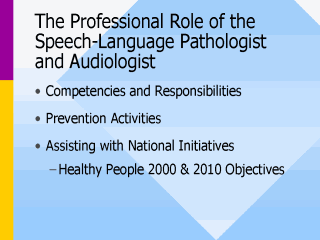| front |1 |2 |3 |4 |5 |6 |7 |8 |9 |10 |11 |12 |13 |14 |15 |16 |17 |18 |19 |20 |review |
 |
Role of
Prevention: The American Speech-Language-Hearing Association has long considered the
prevention of communication disorders as one of the primary responsibilities of
speech-language pathologists and audiologists. In fact, according to ASHA’s mission, one
of the purposes of the organization is to “promote investigations and prevention of
disorders of human communication.” Several Prevention Activities are: 1. A community awareness program for hearing conservation 2. School screenings disorders of speech, language, and voice 3. Family or caregiver education programs Competencies and Responsibilities for Speech-Language Pathologists and Audiologists, according to ASHA’s position statement Prevention of Communication Disorders (1988) outlines 10 competencies that clinicians must have if they are to play a significant role in developing and implementing prevention strategies. These competencies are: (a.) Use prevention terminology appropriately: (b.) Understand conditions that place individuals and populations at risk for various communication disorders: (c.) understand conditions which promote development and maintenance of optimal communication abilities (wellness); (d.), interpret the existing prevention literature in order to apply the information appropriately; (e.) present primary prevention information to groups known to be at risk for communication disorders and other appropriately; (f.) provide individual-, family- and community-focused primary prevention information and services; (g.) provide early identification and early intervention services for communication disorders occurring at any time during the life span; (h.) make appropriate referrals for prevention-related services not provided by speech-language pathologists or audiologists; and (I.) disseminate prevention information to various public sectors including health care professionals, social service professionals, and extended families Another role is in assisting with national initiatives, such as Healthy People 2010 Objectives. Several ways that SLP’s and A’s can participate are by integrating HP objectives into current programs, incorporating HP initiatives into community programs and joining the consortium. Transition Point: There are three levels of prevention: primary, secondary, and tertiary….. |